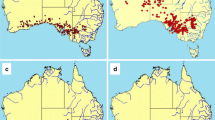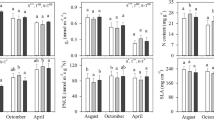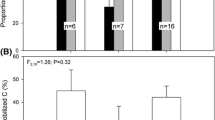Abstract
Plants store non-structural carbohydrates (NSC), nitrogen (N), as well as other macro and micronutrients, in their stems and roots; the role of these stored reserves in plant growth and defense under herbivory pressure is poorly understood, particularly in trees. Trembling aspen (Populus tremuloides) seedlings with different NSC and N reserves accumulated during the previous growing season were generated in the greenhouse. Based on NSC and N contents, seedlings were assigned to one of three reserve statuses: Low N–Low NSC, High N–Medium NSC, or High N–High NSC. In the subsequent growing season, half of the seedlings in each reserve status was subjected to defoliation by forest tent caterpillar (Malacosoma disstria) while the other half was left untreated. Following defoliation, the effect of reserves was measured on foliar chemistry (N, NSC) and caterpillar performance (larval development). Due to their importance in herbivore feeding, we also quantified concentrations of phenolic glycoside compounds in foliage. Seedlings in Low N-Low NSC reserve status contained higher amounts of induced phenolic glycosides, grew little, and supported fewer caterpillars. In contrast, aspen seedlings in High N-Medium or High NSC reserve statuses contained lower amounts of induced phenolic glycosides, grew faster, and some of the caterpillars which fed on these seedlings developed up to their fourth instar. Furthermore, multiple regression analysis indicated that foliar phenolic glycoside concentration was related to reserve chemistry (NSC, N). Overall, these results demonstrate that reserves accumulated during the previous growing season can influence tree defense and growth in the subsequent growing season. Additionally, our study concluded that the NSC/N ratio of reserves in the previous growing season represents a better measure of resources available for use in defense and growth than the foliar NSC/N ratios.



Similar content being viewed by others
References
Babst BA, Ferrieri RA, Gray DW, Lerdau M, Schlyer DJ, Schueller M, Thorpe MR, Orians CM (2005) Jasmonic acid induces rapid changes in carbon transport and partitioning in Populus. New Phytol 167:63–72
Babst BA, Ferrieri RA, Thorpe MR, Orians CM (2008) Lymantria dispar herbivory induces rapid changes in carbon transport and partitioning in Populus nigra. Entomol Exp Appl 128:117–125
Barbehenn RV, Constabel CP (2011) Tannins in plant–herbivore interaction. Phytochemistry 72:1551–1565
Barbehenn RV, Jones CP, Yip L, Tran L, Constabel CP (2007) Limited impact of elevated levels of polyphenol oxidase on tree-feeding caterpillars: assessing individual plant defenses with transgenic poplar. Oecologia 154:129–140
Bernhardsson C, Robinson KM, Abreu IN, Benedicte SJ, Albrectsen BR, Ingvarsson PK (2013) Geographic structure in metabolome and herbivore community co-occurs with genetic structure in plant defence genes. Ecol Let 16:791–79
Bonello P, Gordon TR, Herms D, Wood DL, Erbilgin N (2006) Nature and ecological implications of pathogen-induced systemic resistance in conifers: a novel hypothesis. Phys Mol Plant Path 68:95–104
Bremner, J.M., and Mulvaney, C.S. 1982. Nitrogen-total. In: Page, A.L. (ed) Methods of soil analysis. Part 2. Chemical and microbiological properties. American Society of Agronomy, Madison, Wisconsin, pp 595–624
Bryant JP, Chapin FS, Klein DR (1983) Carbon/nutrient balance of boreal plants in relation to vertebrate herbivory. Oikos 40:357–368
Bryant JP, Clausen TP, Reichardt PB, McCarthy MC, Werner RA (1987) Effect of nitrogen fertilization upon the secondary chemistry and nutritional value of quaking aspen (Populus tremuloides Michx.) leaves for the large aspen tortrix (Choristoneura conflictana (Walker)). Oecologia 73:513–517
Chow PS, Landhäusser SM (2004) A method for routine measurements of total sugar and starch content in woody plant tissues. Tree Phys 24:1129–1136
Couture JJ, Meehan TD, Lindroth RL (2011) Atmospheric change alters foliar quality of host trees and performance of two outbreak insect species. Oecologia 168:863–876
Donaldson JR, Kruger EL, Lindroth RL (2006) Competition- and resource-mediated trade-offs between growth and defensive chemistry in trembling aspen (Populus tremuloides). New Phytol 169:561–570
Donaldson JR, Lindroth RL (2007) Genetics, environment, and their interaction determine efficacy of chemical defense in trembling aspen. Ecology 88:729–739
Dunn JP, Potter DA, Kimmerer TW (1990) Carbohydrate reserves, radial growth, and mechanisms of resistance of oak trees to phloem-boring insects. Oecologia 83:458–468
Eyles A, Bonello P, Ganley R, Mohammed C (2010) Induced resistance to pests and pathogens in trees. New Phytol 185:893–908
Franceschi VR, Krokene P, Christiansen E, Krekling T (2005) Anatomical and chemical defences of conifer bark beetles and other pests. New Phytol 167:353–375
Frost CJ, Mescher MC, Carlson JE, De Moraes CM (2008) Plant defense priming against herbivores: getting ready for a different battle. Plant Physiol 146:818–824
Galvez DA, Landhäusser SM, Tyrée MT (2013) Low root reserve accumulation during drought may lead to winter mortality in poplar seedlings. New Phytol 198:139–148
Gershenzon J (1994) Metabolic costs of terpenoid accumulation in higher plants. J Chem Ecol 20:1281–1328
Goodsman DW, Lusebrink I, Landhäusser SM, Erbilgin N, Lieffers VJ (2013) Hierarchies in carbon availability, defense chemistry and susceptibility to fungal invasion along tree boles. New Phytol 197:586–594
Grisdale D (1985) Malacosoma disstria. In: Singh P, Moore RF (eds) Handbook of insect rearing. Elsevier. Amsterdam, The Netherlands, pp 369–379
Harrington JT, Mexal JD, Fisher JT (1994) Volume displacement provides a quick and accurate way to quantify new root production. Tree Planter’s Notes 45:121–124
Hemming JDC, Lindroth RL (2000) Effects of phenolic glycosides and protein on gypsy moth (Lepidoptera: Lymantriidae) and forest tent caterpillar (Lepidoptera: Lasiocampidae) performance and detoxication activities. Environ Entomol 29:1108–1115
Hwang SY, Lindroth RL (1997) Clonal variation in foliar chemistry of aspen: effects on gypsy moths and forest tent caterpillars. Oecologia 111:99–108
Jansen JJ, Allwood JW, Marsden-Edwards E, van der Putten WH, Goodacre R, van Dam NM (2009) Metabolomic analysis of the interaction between plants and herbivores RID C-3707–2011 RID B-3281–2008. Metabolomics 5:150–161
Kalra, Y,P., and Maynard, D.G. 1991. Methods manual for forest soil and plant analysis. Information Report NOR-X319
Landhäusser SM, Lieffers VJ (2002) Leaf area renewal, root retention and carbohydrate reserves in a clonal tree species following aboveground disturbance. J Ecol 90:658–665
Landhäusser SM, Lieffers VJ (2012) Defoliation increases risk of carbon starvation in root systems of mature aspen. Trees- Struc Func 26:653–661
Landhäusser SM, Pinno BD, Lieffers VJ, Chow PS (2012a) Partitioning of carbon allocation to reserves or growth determines future performance of aspen seedlings. For Ecol Manag 275:43–51
Landhäusser SM, Rodriguez-Alvarez J, Marenholtz EH, Lieffers VJ (2012b) Effect of stock type characteristics and time of planting on field performance of aspen (Populus tremuloides Michx.) seedlings on boreal reclamation sites. New For 43:679–693
Legendre, P., and Durand, S. 2010. rdaTest, Canonical redundancy analysis. R package version 1.7
Lindroth RL, Kinney KK, Platz CL (1993) Responses of deciduous trees to elevated atmospheric CO2: productivity, phytochemistry, and insect performance. Ecology 74:763–777
Lindroth RL, Roth SK, Nordheim EV (2001) Genotypic variation in response of quaking aspen (Populus tremuloides) to atmospheric CO2 enrichment. Oecologia 126:371–379
Lindroth RL, St Clair SB (2013) Adaptations of quaking aspen (Populus tremuloides Michx.) for defense against herbivores. For Ecol Manag 299:14–21
Macdonald, S.E., Quideau, S.A., and Landhäusser, S.M. 2012. Rebuilding boreal forest ecosystems after industrial disturbance. In: Reclamation and restoration of boreal ecosystems: attaining sustainable development. Edited by Dale Vitt and Jag Bhattia. Cambridge University Press, pp 123-160
McDowell N, Pockman WT, Allen CD, Breshears DD, Cobb N, Kolb T, Plaut J, Sperry J, West A, Williams DG, Yepez EA (2008) Mechanisms of plant survival and mortality during drought: why do some plants survive while others succumb to drought? New Phytol 178:719–739
Orians CM, Thorn A, Gómez S (2011) Herbivore-induced resource sequestration in plants: why bother? Oecologia 167:1–9
Osier TL, Lindroth RL (2001) Effects of genotype, nutrient availability, and defoliation on aspen phytochemistry and insect performance. J Chem Ecol 27:1289–1313
Sala A, Woodruff DR, Meinzer FC (2012) Carbon dynamics in trees: feast or famine? Tree Phys 32:764–775
Sampedro L, Moreira X, Zas R (2011) Costs of constitutive and herbivore-induced chemical defences in pine trees emerge only under low nutrient availability. J Ecol 99:818–827
Schott KM, Pinno BD, Landhäusser SM (2013) Premature shoot growth termination allows nutrient loading of seedlings with an indeterminate growth strategy. New For 44:635–647
Sprugel DG (2002) When branch autonomy fails: Milton’s Law of resource availability and allocation. Tree Phys 22:1119–1124
Stevens MT, Kruger EL, Lindroth RL (2008) Variation in tolerance to herbivory is mediated by differences in biomass allocation in aspen. Funct Ecol 22:40–47
Zhao W, Chen S, Lin G (2008) Compensatory growth responses to clipping defoliation in Leymus chinensis (Poaceae) under nutrient addition and water deficient conditions. Plant Ecol 196:85–99
Acknowledgments
We acknowledge the contribution of Dr. Staffan Lindgren (University of Northern British Columbia) and Amy Nixon (University of Alberta) in providing egg masses of forest tent caterpillar for the herbivory experiment. We also thank Dr. Richard Lindroth (University of Wisconsin, Madison) for supplying tremuloidin for phenolic glycoside analysis in HPLC. Dr. J Karst (University of Alberta) provided comments on the earlier version of this paper. This study was funded by Natural Sciences and Engineering Research Council of Canada – Discovery to SML and NE. Dr. Guillaume Blanchet helped with the statistical analysis and Pak Chow conducted the carbohydrate analysis.
Author information
Authors and Affiliations
Corresponding author
Rights and permissions
About this article
Cite this article
Najar, A., Landhäusser, S.M., Whitehill, J.G.A. et al. Reserves Accumulated in Non-Photosynthetic Organs during the Previous Growing Season Drive Plant Defenses and Growth in Aspen in the Subsequent Growing Season. J Chem Ecol 40, 21–30 (2014). https://doi.org/10.1007/s10886-013-0374-0
Received:
Revised:
Accepted:
Published:
Issue Date:
DOI: https://doi.org/10.1007/s10886-013-0374-0




